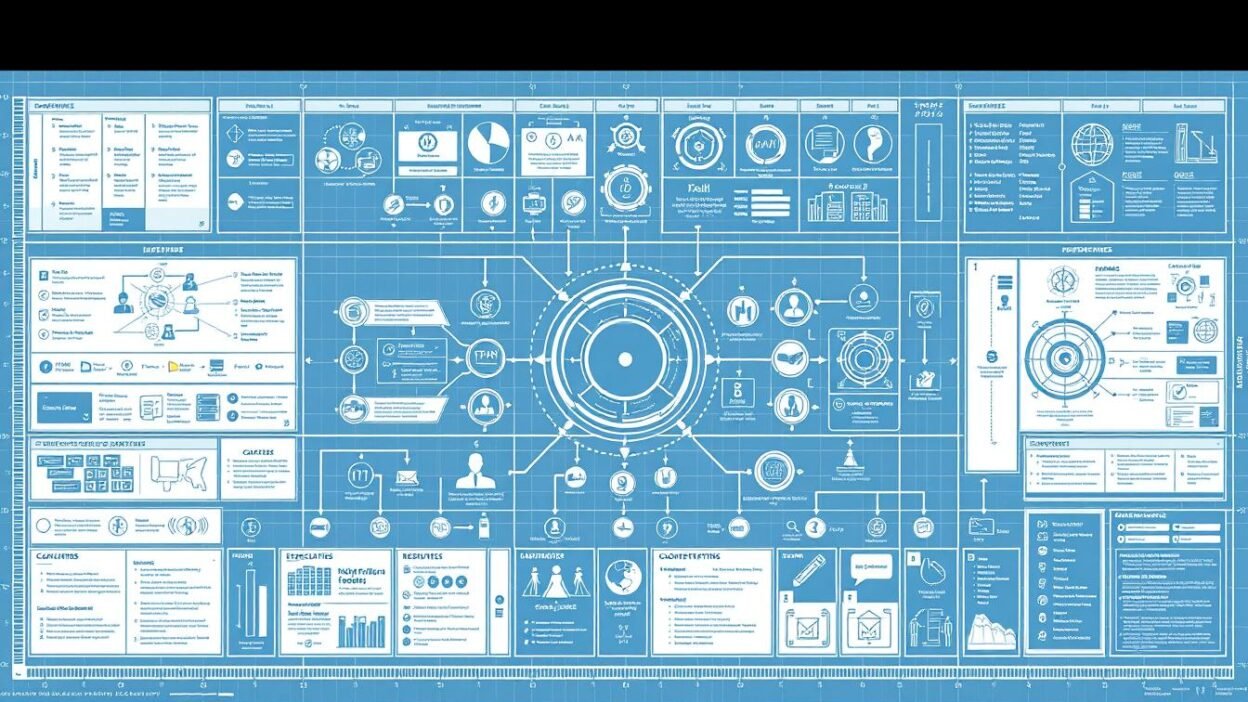Can a curriculum really get students ready for real-world challenges if it focuses on textbooks more than practical skills? Schools worldwide are asking this as they try to match learning with today’s job needs. Competency-Based Curriculum (CBC) is a significant change, moving from just covering content to mastering skills that can be shown.
In India, this change is key. It helps teachers prepare students for jobs that keep changing fast. This guide shows how to design curricula focusing on skills students can show off. It allows schools and colleges to ensure students are ready for the real world.
Key Takeaways
Key Takeaways
- Competency-based curriculum prioritizes skill mastery over time spent in classrooms.
- Effective curriculum design requires aligning learning outcomes with industry standards.
- Technology integration is essential for tracking competency progression
- Indian educational institutions face unique implementation challenges
- Continuous feedback loops improve curriculum effectiveness over time
Understanding Competency-Based Curriculum
Competency-based curriculum (CBC) changes how we learn by focusing on mastering skills, not just time. It makes learning personal and centered on the student. This way, education meets the needs of the real world, not just a calendar.
“Competency-based education ensures learners acquire skills necessary for societal and professional roles, not just academic credentials.”
What is a Competency-Based Curriculum?
CBC bases education on clear skills like coding or analytical thinking. It’s different from old systems where grades come from age. Now, students show they’ve learned by doing projects or passing tests.
For example, a medical student might advance in pharmacology after solving patient cases. India’s new education policy supports this to make learning more practical.
Importance of Competency in Education
This method fills gaps in old schools by making learning count. It helps students get jobs and adapt to new situations. It also lets students learn independently without rushing or getting stuck.
Studies show CBC cuts skill gaps by 40% in tests. This is a big win for education.
Key Characteristics of Competency-Based Learning
- Mastery-Driven Progression: Learners move on when they’ve mastered skills.
- Flexible Pacing: Learning fits each student’s speed, not a fixed schedule.
- Authentic Assessments: Real-world tests replace old ways of checking knowledge.
- Transparency: It’s clear what skills are needed for each part of learning.
Benefits of Implementing a Competency-Based Curriculum
Competency-based curricula change how we measure learning. They focus on skills mastery, not just grades. This method links learning to real-world skills, boosting student success.
Schools that use this approach see significant changes. Students are more engaged, stay longer, and grow in their own way.
Enhanced Student Engagement
Students now take on real-world projects instead of just listening. A 2023 study found 78% of learners felt more motivated. This shows how skills development boosts engagement.
This new way of learning makes students see the value in their studies. It helps them stay motivated for the long haul.
Improved Retention of Knowledge
Students learn deeply before moving on. They show they know it by doing projects or tests. This builds strong learning foundations.
A study in the Indian Journal of Education Policy found that forgetting dropped by 40%. This is because students keep practicing what they learn.
Flexibility and Personalization
- Adaptive pacing: Students move at their own speed, avoiding unnecessary work.
- Cultural relevance: Lessons fit local needs, helping India’s diverse schools.
- Support systems: Teachers offer help tailored to each student’s needs.
“Competency models turn classrooms into skill workshops, preparing learners to navigate both academic and career challenges.” — Dr. Rukmini Banerjee, Director, Pratham Education Foundation
This flexibility helps all students, not just some. It also speeds up those who are ready to learn more. This matches India’s goal of measuring fair student success.
Key Steps in Developing a Competency-Based Curriculum
Creating a competency-based curriculum needs a clear plan. It starts with competency mapping. This step requires teamwork between teachers and industry experts to find the most needed skills. India’s National Education Policy 2020 highlights the importance of matching curricula with societal needs. This is vital for institutions like IITs or AMU’s School of Education.
Identifying Core Competencies
Competency mapping involves three main steps:
- Conducting needs analyses with employers and policymakers
- Analyzing academic standards from NCTE and state education boards
- Prioritizing competencies using Bloom’s Taxonomy frameworks
“Competency mapping bridges theory and practice, ensuring graduates possess skills employers demand.” — Dr. Anuradha Shrivastava, NUEPA
Defining Learning Outcomes
Learning outcomes should be clear and measurable. For instance:
- “Students will design a sustainable urban plan using GIS tools within 12 weeks.”
- “Demonstrate ethical decision-making in 90% of case studies.”
These learning outcomes help shape lessons and tests. BITS Pilani’s engineering programs are a great example of this.
Designing Assessments Aligned with Competencies
Assessment methods should reflect real-world scenarios. Consider:
- Portfolio reviews tracking skill progression
- Simulation-based evaluations for medical students at AIIMS
- Peer assessments using rubrics from AICTE guidelines
These approaches ensure skills are proven through clear, consistent evidence of mastery.
Best Practices for Curriculum Development
Educational innovation grows when we work together and adapt. Good curriculum design needs a clear plan. It should mix learning with real-life skills, fitting India’s varied schools.
Involving Stakeholders
Getting everyone involved is key to good curriculum design. Schools like the Apeejay School Group listen to teachers, parents, and businesses. This makes sure what we learn meets society’s needs.
“Engaging stakeholders transforms abstract concepts into actionable strategies,” states Dr. Anita Rampal, education policy expert at O.P. Jindal Global University.
Regular talks and online forums help keep curricula up-to-date. They make sure learning fits local and cultural needs.
Continuous Improvement through Feedback
Feedback is essential for making curricula better. Places like the Indian Institute of Management (IIM) follow these steps:
- Anonymous student surveys measuring skill acquisition
- Faculty peer reviews of module effectiveness
- Quarterly alumni assessments tracking career outcomes
This feedback helps change what we learn and how we’re tested. It keeps curricula fresh and relevant.
Aligning with Industry Needs
Curriculum design should match what the job market wants. Schools team up with companies like Tata Group. They make sure what we learn is useful for jobs.
Meetings with industry experts and internships at places like Infosys keep learning current. This shows how education meets the real world.
Integrating Technology in Competency-Based Learning
Technology and teaching come together in competency-based learning. Schools use digital tools to improve curricula, assess student performance, and tailor learning. This approach meets today’s educational needs and tackles challenges like India’s varied school readiness.
Tools for Curriculum Development
Software like Compass Learning and Defined Learning help teachers organize learning goals. These tools let teams work together, making sure learning meets real-world standards. They also help keep curricula organized and ready for the future.
Online Assessment Solutions
Adaptive tools like ExamSoft and Hapara make assessments more detailed. They offer tests that mimic real-world scenarios, from virtual labs to group projects. For example, engineering students can show off their problem-solving skills through digital projects, not just tests.
Learning Management Systems (LMS)
Systems like Moodle and Canvas help track student progress. They give detailed reports on how students are doing, spotting areas where they need help. Schools like the IITs use these systems to update courses quickly, keeping up with industry changes.
“Technology democratizes access but demands intentional planning. Infrastructure gaps must be addressed to ensure equitable educational innovation.”
Despite digital skills and infrastructure hurdles, these technologies can change competency-based education. It moves from just an idea to something that can grow and improve.
Challenges in Adopting a Competency-Based Curriculum
Switching to a Competency-Based Curriculum (CBC) is tough. It tests how strong a school is. People might not like new ways of learning.
Teachers who are used to the old ways might doubt new tests. Bosses face problems like fitting new plans into old systems.
Resistance to Change
- Faculty: Concerns over workload spikes and assessment design unfamiliarity
- Administrators: Struggles with aligning CBC frameworks to existing governance structures
- Stakeholders: Skepticism about credential recognition in India’s traditional academic ecosystems
Resource Constraints
In India, schools often lack what they need for a student-centered approach:
- Faculty training programs remain underfunded
- Technology infrastructure lags behind curriculum demands
- Lack of tailored learning materials for diverse competency levels
Ensuring Consistency and Quality
Expanding CBC needs strict quality checks:
- Standardized rubrics for competency evaluation
- Inter-institutional moderation committees
- Regular audits of instructional material alignment
“The real challenge lies not in designing the curriculum, but in sustaining its implementation amid competing priorities.” – Dr. Rajesh Mehta, National Education Policy Advisor
To overcome these hurdles, schools need a plan. They should start small, add resources bit by bit, and work together on rules. This way, they can introduce CBC without losing focus on quality education.
Case Studies: Successful Implementations in India
Competency-based education is growing in India. Schools and colleges are seeing real results with their own methods. They focus on personalized learning and skills development in ways that work for them.
Example 1: A Progressive School’s Approach
In Bangalore, a top K-12 school changed its teaching to focus on skills like thinking critically and using technology. They use personalized learning to help students learn through projects. This way, students can show their progress in digital portfolios.
“Metacognitive journals helped students articulate their learning strategies,”
The school’s leader said. They use tech to give feedback immediately and let students learn at their own pace.
Example 2: Competency Framework in Higher Education
In Maharashtra, a college for engineering teamed up with car companies to create a skills development plan. They taught about robotics and green design, with tests that match industry standards. Workshops and final projects helped graduates find jobs 22% faster, reports from 2023 show.
Students could also focus on new areas like AI and green energy. This made them more ready for the job market.
Lessons Learned from These Implementations
Here are some important lessons:
- Leadership alignment: Getting everyone on board was key to success.
- Industry partnerships: Working with companies made sure what was taught was what employers wanted.
- Faculty training: Teaching teachers about competency-based learning made them 30% more effective.
| Challenge | Solution |
|---|---|
| Resource constraints | They started with the most important changes first |
| Cultural resistance | They held workshops for parents and teachers to understand the new approach. |
These examples show that success comes from mixing global ideas with local teaching styles. Keeping feedback open and assessments flexible is key to keeping these improvements going.
Measuring Success of Competency-Based Curricula
Evaluating competency-based curricula needs a clear performance assessment plan. Schools must use many ways to check both short and long-term results. This makes sure they meet big goals like India’s Skill India Mission.
Key Performance Indicators
Important metrics include:
- Competency attainment rates (percentage of students mastering skills)
- Time-to-mastery benchmarks for critical skills
- Graduation rates and program completion timelines
Student Feedback and Learning Outcomes
Both numbers and words should show learning outcomes. Here’s a look at different types of data:
| Category | Quantitative Metrics | Qualitative Metrics |
|---|---|---|
| Academic Progress | Exam scores, portfolio reviews | Student reflections, peer evaluations |
| Engagement | Login frequency, task completion rates | Focus group insights, satisfaction surveys |
Long-term Impact on Career Readiness
Studies that follow graduates show how well the curriculum works. Important signs include:
- Employment rates within six months of graduation
- Employer feedback on skill alignment with industry needs
- Graduate salary progression over five years
Schools like IIT Bombay show how tracking these signs helps match education with job needs. Being open about learning outcomes builds trust and helps improve education.
Future Trends in Competency-Based Education
Competency-based education is changing fast. It’s showing how it can change what we learn in school. Schools in India and worldwide are working hard to improve learning. They want to help students succeed by using new ways to teach.
The Role of Artificial Intelligence
AI is changing how we learn by making lessons fit each student’s needs. It looks at how well students do and changes what they learn next. But schools must also think about keeping learning fair and safe for everyone.
Lifelong Learning and Upskilling
Learning doesn’t stop when you finish school. Now, you can keep learning new skills. In India, places like the National Skill Development Corporation are helping people learn in small steps. This way, you can keep getting better at your job, which helps you succeed in the long run.
Global Comparisons and Insights
Looking at how different places teach shows us many ways to improve learning. Schools in India can learn from others and make it their own. Working with groups like UNESCO helps find the best teaching methods, considering what works best in each place.
FAQ
What is a Competency-Based Curriculum?
A Competency-Based Curriculum (CBC) focuses on specific skills and knowledge. It emphasizes measurable performance and mastery over time. This approach makes learning personal and prepares students for the real world.
Why is competency critical in education?
Competency is key because it teaches both theory and practical skills. It fits different learning styles and paces. This makes education more focused on the students and prepares them for the workforce.
What are the key characteristics of competency-based learning?
Competency-based learning has several key traits:
- Clear learning outcomes that show what students need to do.
- Flexible pacing lets students move at their own speed.
- Real-world assessments test skills, not just memorization.
- Students have control over their learning path.
These traits make learning engaging and inclusive.
How can educational institutions ensure stakeholder involvement during curriculum development?
Ensuring stakeholder involvement means working with teachers, students, parents, and industry experts. This collaborative effort makes the curriculum more relevant and effective.
What technological tools can support the development of a competency-based curriculum?
Tools like curriculum mapping software, online assessments, and Learning Management Systems (LMS) are helpful. They help educators work together, improve assessments, and create personalized learning plans.
What are some challenges associated with adopting a competency-based curriculum?
Challenges include resistance from faculty and students, limited resources, and ensuring quality. Overcoming these needs careful planning and quality checks.
How can institutions measure the success of a competency-based curriculum?
Institutions can track success by looking at competency rates, student progress, and retention. Also, listening to student feedback and checking long-term career readiness is essential.
What role does artificial intelligence play in competency-based education?
Artificial intelligence transforms competency-based education by creating personalized learning paths. It improves assessments and encourages innovation. But, it also raises concerns about data privacy and bias.





